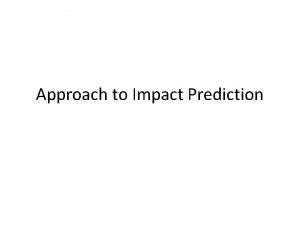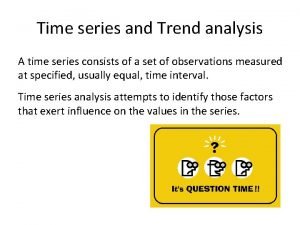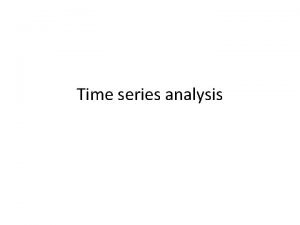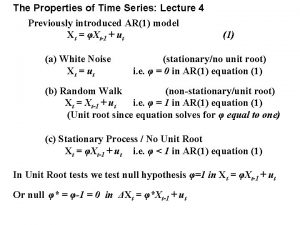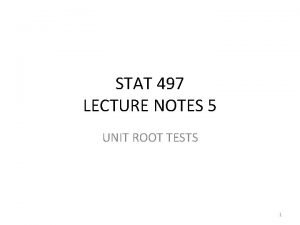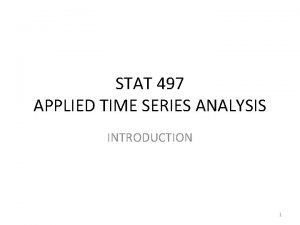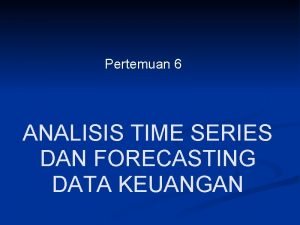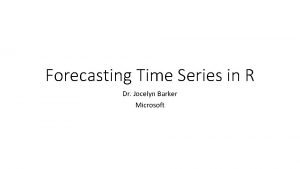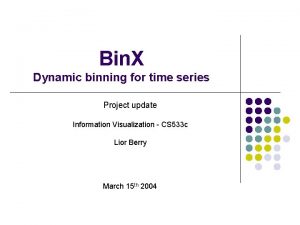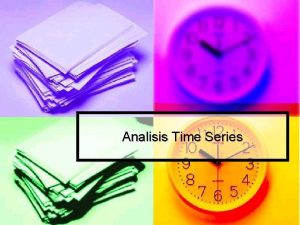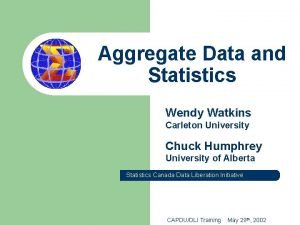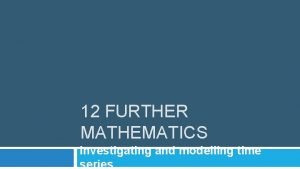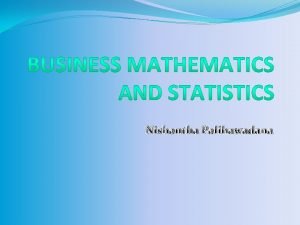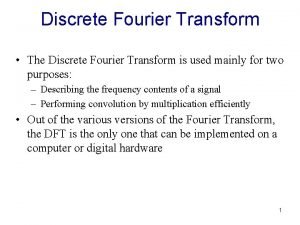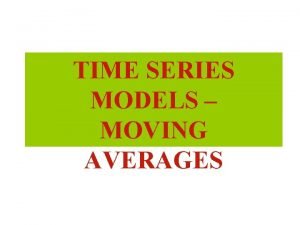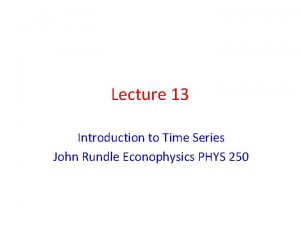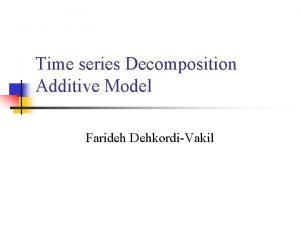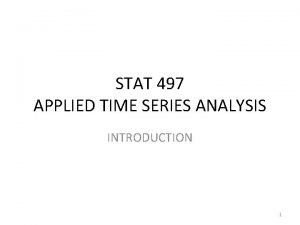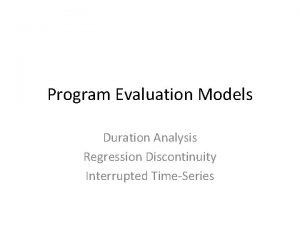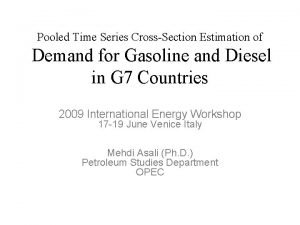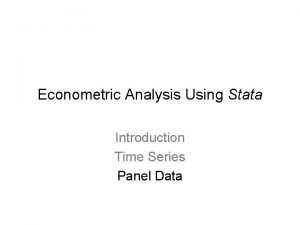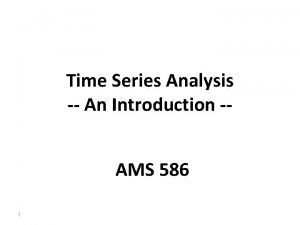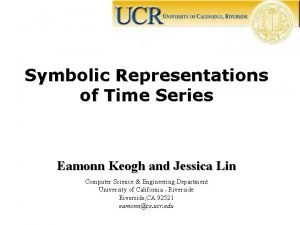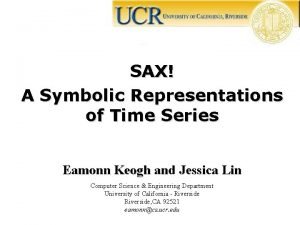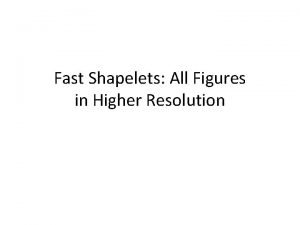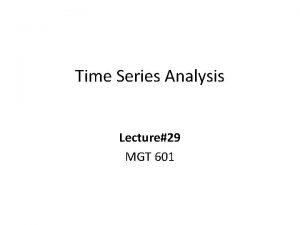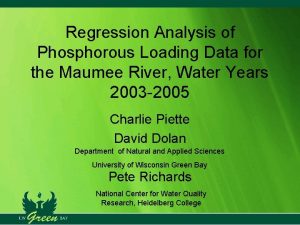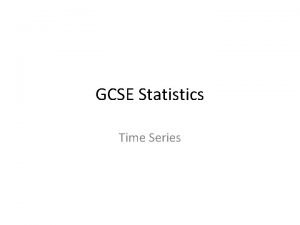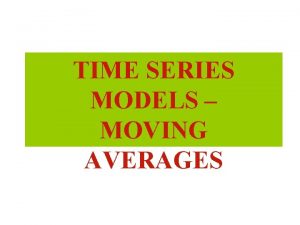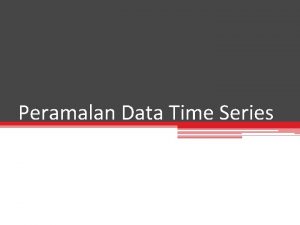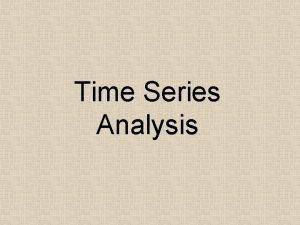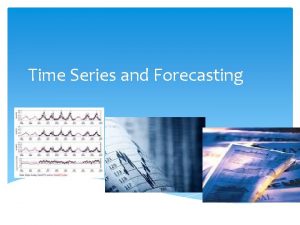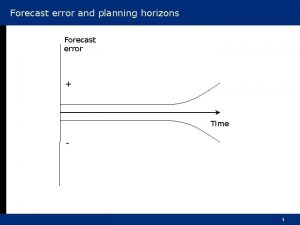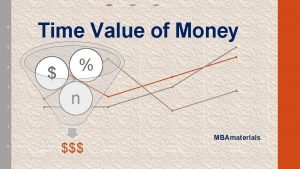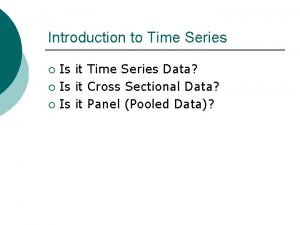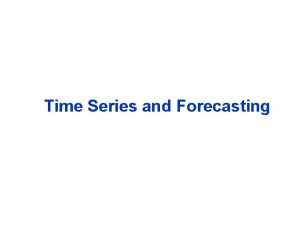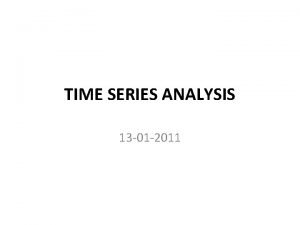TIME SERIES MODELS Definitions Forecast is a prediction


















































- Slides: 50

TIME SERIES MODELS

Definitions • Forecast is a prediction of future events used for planning process. • Time Series is the repeated observations of demand for a service or product in their order of occurrence.

Components of a Time Series • A time series can consist of five components. – Horizontal or Stationary – Fluctuations around a – – Long - term trend (T). Cyclical effect (C). Seasonal effect (S). Random variation (R). Quantity constant mean. Time A trend is a long term relatively smooth pattern or direction, that persists usually for more than one year.

A cycle is a wavelike pattern describing a long term behavior (for more than one year). Cycles are seldom regular, and often appear in combination with other components. The seasonal component of the time series exhibits a short term (less than one year) calendar repetitive behavior. 6/90 6/93 6/96 6/99 6/02 6/97 12/97 6/98 12/98 6/9

Random variation comprises the irregular unpredictable changes in the time series. It tends to hide the other (more predictable) components. Random or Irregular Variation – classified into: • Episodic – unpredictable but identifiable • Residual – also called chance fluctuation and unidentifiable

Moving Average and Exponential Smoothing Methods • Consider models applicable to time series data with seasonal, trend, or both seasonal and trend component and stationary data. Forecasting methods discussed can be classified as: • – Averaging methods. • – Equally weighted observations Exponential Smoothing methods. • • • Unequal set of weights to past data, where the weights decay exponentially from the most recent to the most distant data points. All methods in this group require that certain parameters to be defined. These parameters (with values between 0 and 1) will determine the unequal weights to be applied to past data.

Moving Averages – A n-period moving average for time period t is the arithmetic average of the time series values for the n most recent time periods. – For example: A 3 -period moving average at period (t+1) is calculated by (yt-2 + yt-1 + yt)/3

Centered Moving Average Method The centered moving average method consists of computing an average of n periods' data and associating it with the midpoint of the periods. For example, the average for periods 5, 6, and 7 is associated with period 6.

Moving Averages • A large k is desirable when there are wide, infrequent fluctuations in the series. • A small k is most desirable when there are sudden shifts in the level of series. • For quarterly data, a four-quarter moving average, MA(4), eliminates or averages out seasonal effects.

Moving Averages • For monthly data, a 12 -month moving average, MA(12), eliminate or averages out seasonal effect. • Equal weights are assigned to each observation used in the average. • Each new data point is included in the average as it becomes available, and the oldest data point is discarded.

Summary of Moving Averages • Advantages of Moving Average Method – Easily understood – Easily computed – Provides stable forecasts • Disadvantages of Moving Average Method – Requires saving all past n data points – Lags behind a trend – Ignores complex relationships in data

Simple Moving Average – Example (File: PPT_MA) Period Actual MA 3 MA 5 • Consider the following data, 1 42 2 40 • Starting from 4 th period one can start forecasting by using MA 3. Same is true for MA 5 after the 6 th period. 3 43 4 40 41. 7 5 41 41. 0 6 39 41. 3 41. 2 7 46 40. 0 40. 6 8 44 42. 0 41. 8 9 45 43. 0 42 10 38 45. 0 43 11 40 42. 3 42. 4 41. 0 42. 6 • Actual versus predicted(forecasted) graphs are as follows; 12

Simple Moving Average Example Actual MA 5 MA 3

Sample Excel analysis for Actual, Moving Averages for 3 and 5 periods Period 1 2 3 4 5 6 7 8 9 10 11 Actual 42 40 43 40 41 39 46 44 45 38 40 MA 3 #N/A 41. 66667 41 41. 33333 40 42 43 45 42. 33333 41 MA 5 #N/A 41. 2 40. 6 41. 8 42 43 42. 4 42. 6

Sample Excel analysis for Actual, Centred Moving Averages for 2 and 4 periods Period Actual 1 Avg 2 42 Centered MA 2 NA Avg 4 Centered MA 4 NA 41 2 40 41. 25 41. 5 3 41. 25 43 41. 5 4 40 41 41 40. 25 39 41. 25 46 43. 75 44 44. 75 43. 375 43. 25 45 43 41. 5 10 43 43. 5 44. 5 9 42 42. 5 45 8 41. 125 41. 5 42. 5 7 40. 875 40 6 41. 125 41 40. 5 5 NA 42. 5 41. 75 38 40. 25 NA 39 11 40 NA NA

Sample SPSS analysis for Actual, Centered MA 3 and Prior MA 3 Period Actual MA 3 Prior_MA 3 1 2 3 4 5 6 7 8 9 10 11 41. 7 41. 0 41. 3 40. 0 42. 0 43. 0 45. 0 42. 3 42 40 43 40 41 39 46 44 45 38 40 41. 7 41. 0 41. 3 40. 0 42. 0 43. 0 45. 0 42. 3 41. 0

Sample SPSS graph for Actual, Centered MA 5 and Prior MA 5

Example: Weekly Department Store Sales • The weekly sales figures (in millions of dollars) presented in the following table are used by a major department store to determine the need for temporary sales personnel.

Example: Weekly Department Store Sales • Use a three-week moving average (k=3) for the department store sales to forecast for the week 24 and 26. The forecast for the week 26 is

Example: Weekly Department Store Sales

Problem: Robert’s Drugs During the past ten weeks, sales of cases of Comfort brand headache medicine at Robert's Drugs have been as follows: Week Sales 1 110 6 120 2 115 7 130 3 125 8 115 4 120 9 110 5 125 10 130 If Robert's uses a 3 -period moving average to forecast sales, what is the forecast for Week 11?

Exponential Smoothing Methods • This method provides an exponentially weighted moving average of all previously observed values. • Appropriate for data with no predictable upward or downward trend. • The aim is to estimate the current level and use it as a forecast of future value.

Simple Exponential Smoothing Method • Formally, the exponential smoothing equation is • forecast for the next period. • = smoothing constant. • yt = observed value of series in period t. • = old forecast for period t. – The forecast Ft+1 is based on weighting the most recent observation yt with a weight and weighting the most recent forecast Ft with a weight of 1 -

Simple Exponential Smoothing Method • The implication of exponential smoothing can be better seen if the previous equation is expanded by replacing Ft with its components as follows:

Simple Exponential Smoothing Method • If this substitution process is repeated by replacing Ft-1 by its components, Ft-2 by its components, and so on the result is: • Therefore, Ft+1 is the weighted moving average of all past observations.

Simple Exponential Smoothing Method • The exponential smoothing equation rewritten in the following form elucidate the role of weighting factor . • Exponential smoothing forecast is the old forecast plus an adjustment for the error that occurred in the last forecast.

Simple Exponential Smoothing Method • The value of smoothing constant must be between 0 and 1 • can not be equal to 0 or 1. • If stable predictions with smoothed random variation is desired then a small value of is desire. • If a rapid response to a real change in the pattern of observations is desired, a large value of is appropriate.

Measures of Forecast Errors • • • Cumulative Forecast Error (CFE) Mean Squared Error (MSE) Standard Deviation (σ) Mean Absolute Deviation (MAD) Mean Absolute Percent Error (MAPE)

Choosing a Method Forecast Error Measures of Forecast Error Et = y t – Ft CFE = Et MSE = MAD = E t 2 = n |Et | n MAPE = (E t – E )2 n– 1 [ |Et | (100) ] / yt n

Example The following table shows the actual sales of upholstered chairs for a furniture manufacturer and the forecasts made for each of the last eight months. Calculate CFE, MSE, σ, MAD and MAPE for this product.

Choosing a Method Forecast Error Month, Demand, t yt 1 2 3 4 5 6 7 8 200 240 300 270 230 260 210 275 Forecast, Error, Ft Et 225 220 285 290 250 240 Total Absolute Error Absolute Percent Squared, Error, 2 Et |Et| (|Et|/yt)(100) -25 20 15 – 20 20 – 40 35 625 400 225 400 400 1600 1225 25 20 15 20 20 20 40 35 12. 5% 8. 3 5. 0 7. 4 8. 7 7. 7 19. 0 12. 7 – 15 5275 195 81. 3%

Choosing a Method Forecast Error Measures of Error CFE = – 15 Month, Demand, Forecast, Error, – 15 Et E =t =D–t 1. 875 Ft 1 2 MSE 3= 4 5 6 7 8 8 200 240 5275 300 = 8 270 230 = 27. 4 260 210 195 275 MAD = 8 225 220 285 659. 4 290 250 240 = 24. 4 Total 81. 3% MAPE = = 10. 2% 8 Absolute Error Absolute Percent Squared, Error, 2 Et |Et| (|Et|/Dt)(100) – 25 20 15 – 20 20 – 40 35 625 400 225 400 400 1600 1225 25 20 15 20 20 20 40 35 12. 5% 8. 3 5. 0 7. 4 8. 7 7. 7 19. 0 12. 7 – 15 5275 195 81. 3%

Measures of Forecast Accuracy • Choose MSE if it is important to avoid (even a few) large errors. Otherwise, use MAD / MAPE. • A useful procedure for model selection. – Use some of the observations to develop several competing forecasting models. – Run the models on the rest of the observations. – Calculate the accuracy of each model. – Select the model with the best accuracy measure.

Example: Robert’s Drugs During the past ten weeks, sales of cases of Comfort brand headache medicine at Robert's Drugs have been as follows: Week Sales 1 110 6 120 2 115 7 130 3 125 8 115 4 120 9 110 5 125 10 130 If Robert's uses exponential smoothing to forecast sales, which value for the smoothing constant , =. 1 or =. 8, gives better forecasts?

Example: Robert’s Drugs • Exponential Smoothing To evaluate the two smoothing constants, determine how the forecasted values would compare with the actual historical values in each case. Let: Yt = actual sales in week t Ft = forecasted sales in week t F 1 = Y 1 = 110 For other weeks, Ft+1 =. 1 Yt +. 9 Ft

Example: Robert’s Drugs • Exponential Smoothing For =. 1, 1 - =. 9 F 1 = 110 F 2 =. 1 Y 1 +. 9 F 1 =. 1(110) +. 9(110) = 110 F 3 =. 1 Y 2 +. 9 F 2 =. 1(115) +. 9(110) = 110. 5 F 4 =. 1 Y 3 +. 9 F 3 =. 1(125) +. 9(110. 5) = 111. 95 F 5 =. 1 Y 4 +. 9 F 4 =. 1(120) +. 9(111. 95) = 112. 76 F 6 =. 1 Y 5 +. 9 F 5 =. 1(125) +. 9(112. 76) = 113. 98 F 7 =. 1 Y 6 +. 9 F 6 =. 1(120) +. 9(113. 98) = 114. 58 F 8 =. 1 Y 7 +. 9 F 7 =. 1(130) +. 9(114. 58) = 116. 12 F 9 =. 1 Y 8 +. 9 F 8 =. 1(115) +. 9(116. 12) = 116. 01 F 10=. 1 Y 9 +. 9 F 9 =. 1(110) +. 9(116. 01) = 115. 41

Example: Robert’s Drugs • Exponential Smoothing For =. 8, 1 - =. 2 F 1 = 110 F 2 =. 8(110) +. 2(110) = 110 F 3 =. 8(115) +. 2(110) = 114 F 4 =. 8(125) +. 2(114) = 122. 80 F 5 =. 8(120) +. 2(122. 80) = 120. 56 F 6 =. 8(125) +. 2(120. 56) = 124. 11 F 7 =. 8(120) +. 2(124. 11) = 120. 82 F 8 =. 8(130) +. 2(120. 82) = 128. 16 F 9 =. 8(115) +. 2(128. 16) = 117. 63 F 10=. 8(110) +. 2(117. 63) = 111. 53

Example: Robert’s Drugs • Mean Squared Error In order to determine which smoothing constant gives the better performance, calculate, for each, the mean squared error for the nine weeks of forecasts, weeks 2 through 10 by: [(Y 2 -F 2)2 + (Y 3 -F 3)2 + (Y 4 -F 4)2 +. . . + (Y 10 -F 10)2]/9

Example: Robert’s Drugs =. 1 Week 1 2 3 4 5 6 7 8 9 10 Yt 110 115 120 125 120 130 115 110 130 MSE Ft 110. 00 110. 50 111. 95 112. 76 113. 98 114. 58 116. 12 116. 01 115. 41 Sum/9 (Yt - Ft)2 25. 00 210. 25 64. 80 149. 94 36. 25 237. 73 1. 26 36. 12 212. 87 974. 22 108. 25 =. 8 Ft (Yt - Ft)2 110. 00 114. 00 122. 80 120. 56 124. 11 120. 82 128. 16 117. 63 111. 53 Sum/9 25. 00 121. 00 7. 84 19. 71 16. 91 84. 23 173. 30 58. 26 341. 27 847. 52 94. 17

Seasonal Analysis • Seasonal variation may occur within a year or within a shorter period (month, week) • To measure the seasonal effects we construct seasonal indices. • Seasonal indexes express the degree to which the seasons differ from the average time series value across all seasons.

Computing Seasonal Indices • Remove the effects of the seasonal and random variations by regression analysis = b 0 + b 1 t > > • For each time period compute the ratio yt/yt This is based on the Multiplicative Mo which removes most of the trend variation • For each season calculate the average of yt/yt which provides the measure of seasonality. • Adjust the average above so that the sum of averages of all seasons is 1 (if

Computing Seasonal Indices • Example – Calculate the quarterly seasonal indices for hotel occupancy rate in order to measure seasonal variation. – Data:

Computing Seasonal Indices • Perform regression analysis for the model y = b 0 + b 1 t + e where t represents the time, and y represents the occupancy rate. Time (t) Rate 1 0. 561 2 0. 702 3 0. 800 4 0. 568 5 0. 575 6 0. 738 7 0. 868 8 0. 605. . The regression line represents tren

> The Ratios yt / yt t yt Ratio 1. 561. 645. 561/. 645=. 870 2. 702. 650. 702/. 650=1. 08 3 …………………………. =. 639368+. 005245(1) No trend is observed, but seasonality and randomness still exist.

The Average Ratios by Seasons • To remove most of the random variation but leave the seasonal effects, average the terms for each season. Average ratio for quarter (. 870 1: +. 864 +. 865 +. 879 +. 913)/5 Average ratio for quarter 2: (1. 080+1. 100+1. 067+. 993+1. Average ratio for quarter 3: (1. 221+1. 284+1. 046+1. 122+1 Average ratio for quarter 4: (. 860 +. 888 +. 854 +. 874 +. 9

Adjusting the Average Ratios • In this example the sum of all the averaged ratios must be 4, such that the average ratio per season is equal to 1. • If the sum of all the ratios is not 4, we need to adjust them proportionately. Suppose the sum of ratios is equal to 4. 1. Then each ratio will be multiplied by 4/4. 1. (Seasonal averaged ratio) (number of Seasonal index = seasons) Sum of averaged ratios In our problem the sum of all the averaged ratios is equ. 878 + 1. 076 + 1. 171 +. 875 = 4. 0. No normalization is needed. These ratios become the seasonal indices.

Interpreting the Seasonal Indices • The seasonal indexes tell us what is the ratio between the time series value at a certain season, and the overall seasonal average. 17. 1% above the • In our problem: annual average 7. 6% above the annual average Annual average occupancy (100%) 107. 6% 87. 8% 12. 2% below the annual average 117. 1% 12. 5% below the annual average 87. 5% Quarter 1 Quarter 2 3 Quarter 4 1 Quarter 2 3 Quarter

The Smoothed Time Series • The trend component and the seasonality component are recomposed using the multiplicative model. In period #1 ( quarter 1): In period #2 ( quarter 2): Actual series Smoothed series The linear trend (regression) line

Deseasonalized Time Series Seasonally adjusted time. Actual series time = series Seasonal index By removing the seasonality, we can identify changes in the other components of the time series, that might have occurred over time.

Deseasonalized Time Series In period #1 ( quarter 1): In period #4 ( quarter 2): In period #5 ( quarter 1): There was a gradual increase in occupancy ra
 Mathematical models for impact prediction
Mathematical models for impact prediction Stealing machine learning models via prediction apis
Stealing machine learning models via prediction apis Stealing machine learning models via prediction apis
Stealing machine learning models via prediction apis Difference between model and semi modals
Difference between model and semi modals P series ibm
P series ibm Start time end time and elapsed time
Start time end time and elapsed time Maclaurin series vs taylor series
Maclaurin series vs taylor series Heisenberg 1925 paper
Heisenberg 1925 paper Maclaurin series vs taylor series
Maclaurin series vs taylor series Maclaurin polynomial
Maclaurin polynomial General
General Series aiding and series opposing
Series aiding and series opposing Sum of infinite series
Sum of infinite series Secular trend in time series
Secular trend in time series Objective of time series analysis
Objective of time series analysis Unit root time series
Unit root time series Stat root word
Stat root word Applied time series analysis pdf
Applied time series analysis pdf Analisis time series
Analisis time series Ausbeer data in r
Ausbeer data in r Time series binning
Time series binning Pengertian analisis time series
Pengertian analisis time series Aggregating time series data
Aggregating time series data Time series further maths
Time series further maths Sequence definition
Sequence definition Discrete time fourier series
Discrete time fourier series Define discrete fourier transform
Define discrete fourier transform Dtft representation of
Dtft representation of Centered moving average
Centered moving average Covariance of two time series
Covariance of two time series Time series collection
Time series collection Error correction model
Error correction model Additive model time series
Additive model time series Time series definition
Time series definition Interrupted time series vs regression discontinuity
Interrupted time series vs regression discontinuity Pooled time series cross-section analysis
Pooled time series cross-section analysis Time series analysis using stata
Time series analysis using stata Importance of time series analysis
Importance of time series analysis Components of time series
Components of time series Time series motifs
Time series motifs Sax time series
Sax time series Time series forecasting
Time series forecasting Fourier transform of 1
Fourier transform of 1 Time series shapelets
Time series shapelets The time series consists of
The time series consists of Teknik analisis data time series
Teknik analisis data time series Time series gcse
Time series gcse Scala time series
Scala time series To make predictions we often use
To make predictions we often use Championship branch prediction
Championship branch prediction Corner prediction
Corner prediction
